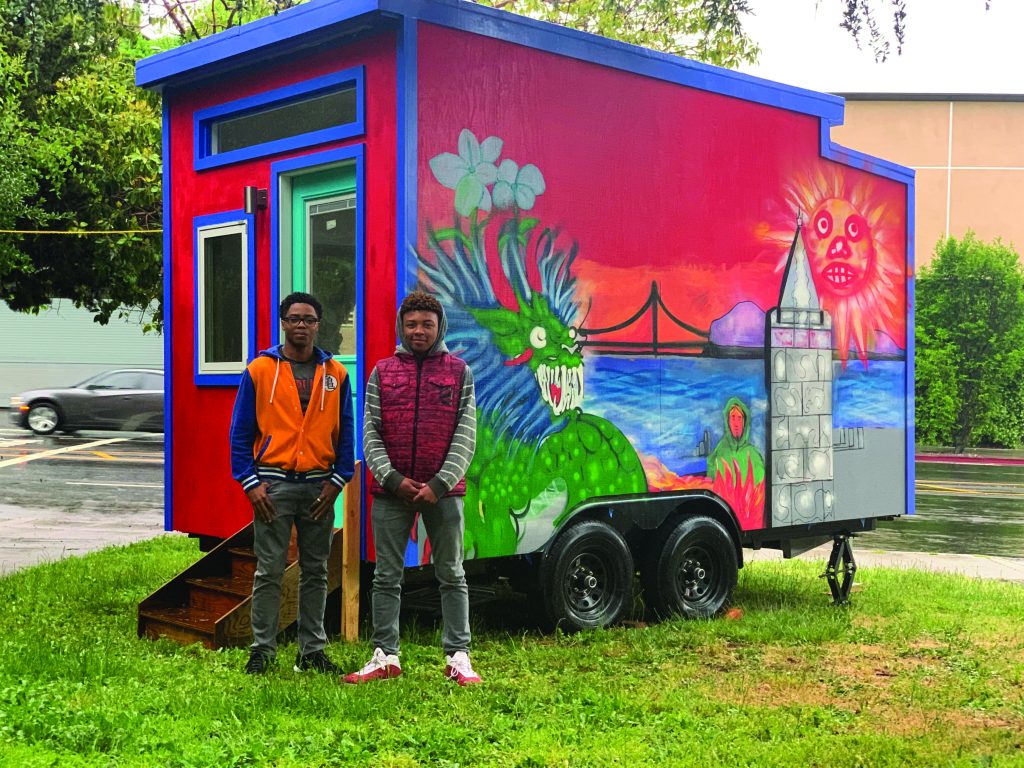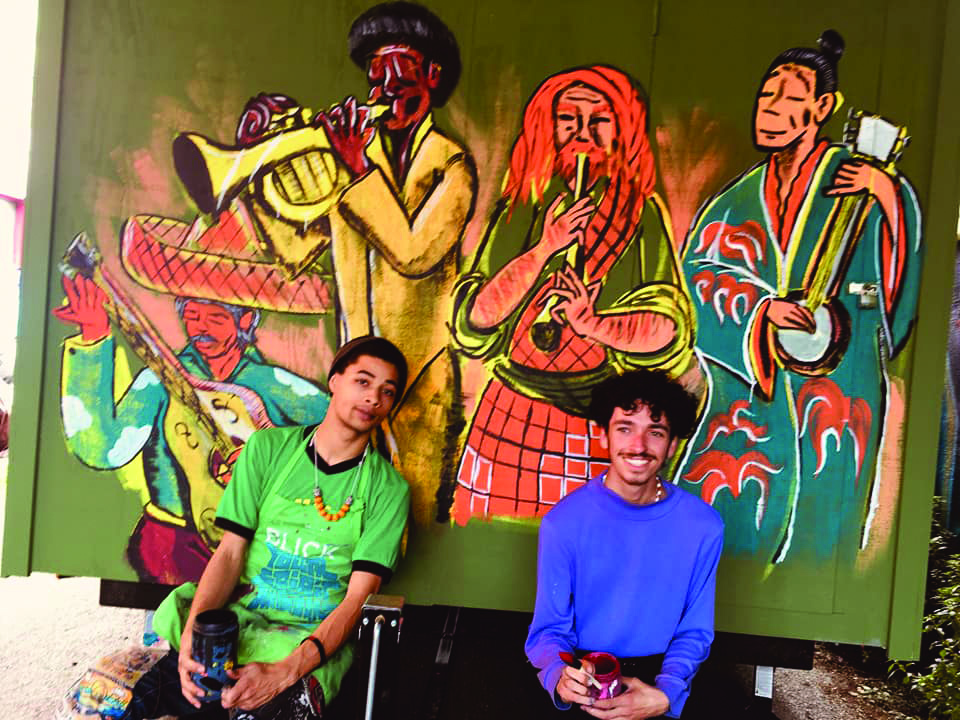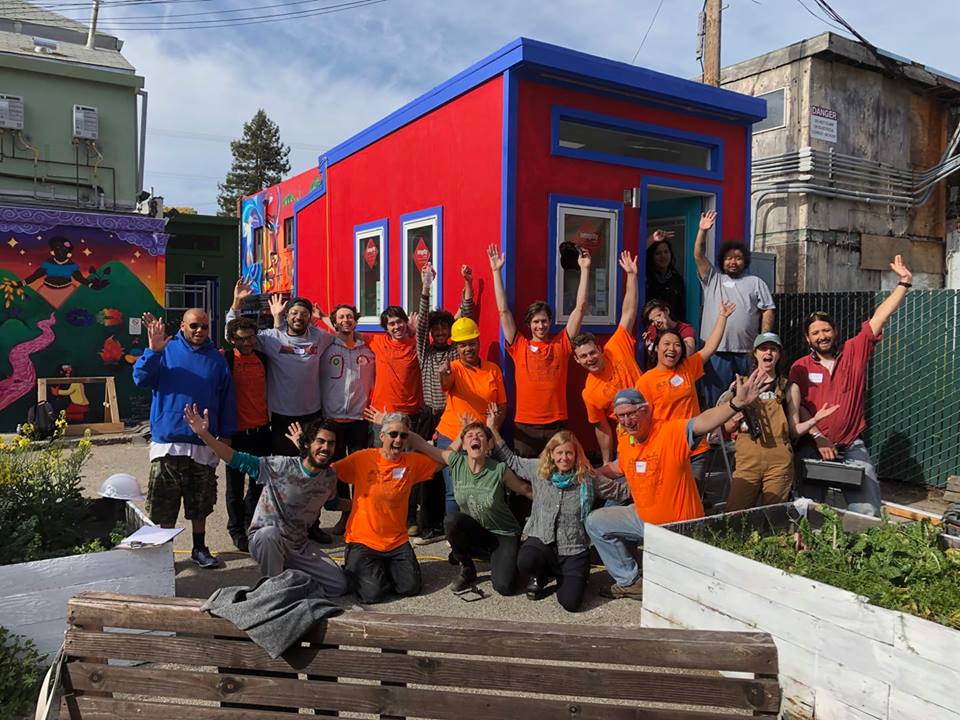
On Thursday, May 16, at the First Congregational Church of Oakland, the youth leaders of Youth Spirit Artworks unveiled what they believe is a solution to the East Bay’s affordability crisis: a 70 square foot Tiny House, featuring a skylight, several windows, two doors, solar-energy heated floors, and two brightly-painted murals along each length of its exterior.
Their presentation was part of the East Bay Housing Organizations’ (EBHO) annual “Affordable Housing Week”: a week of events hosted by partner organizations and in keeping with the theme of housing justice.

Two youth from Youth Spirit Artworks (YSA)—Zaire Caldwell and Jason Wilson—took the stand on Thursday, introducing the organization’s Tiny House Village project. (Disclaimer: Youth Spirit Artworks is the publisher of Street Spirit.) When completed, YSA’s Tiny House Village will be the first in the nation to pro- vide homes for currently unhoused youth. At first, it will include 14 tiny houses, and eventually grow to as many as 25, with one person living in each home. The village will also include a communal kitchen, bathroom, and living space stocked with art supplies, where weekly youth-led community meetings will be held.
Caldwell and Wilson answered questions on its status and future, and shared stories about their experiences on the project.
“When we built the first Tiny House, it was a lot more learn- ing-based and informative,” Caldwell said, referring to his experience helping build the first Tiny House prototype with other YSA participants. “By the second one, I felt more like I needed to step up and make decisions, make sure things were going smoothly. I took on more of a leadership role.”
Caldwell and Wilson have since taken on further leadership roles, working to arrange media representation, facilitate donations, and organize volunteer builders for the project.
Caldwell and Wilson’s leadership is indicative of the ethos of the Tiny House project: It will be distinct from other micro housing-for-the- homeless models—such as the City of Oakland’s Tuff Sheds or San Jose’s village of tiny houses—because every part of the project has been designed by the people who are going to use it. This central theme of community ownership will play an important role in the day-to-day operations of the Tiny House Village.

“It’s going to have a restorative justice model, where the community decides what their values and limitations are, and how they want to engage with any conflicts that arise,” said Hannah Trumbull, YSA’s Inter- faith Organizer. “It’s going to feel more like a home and a community that people created together.”
The concept for the Tiny House Village was created by a group of YSA’s youth participants who had been living in local shelters or on church floors. Frustrated by the lack of permanent supportive housing, they conceived of a solution where they might have their own space, which could be supported by the network of friends, supportive services, and jobs training programs they have found at YSA. In March of 2016, these young people began holding bi-weekly meetings at YSA to turn their vision into a reality.
“Adults have a much better chance of getting a job or income, but youth— who don’t have experience, who should be in school but can’t—are at
a bigger disadvantage,” said Wilson. “That’s why we can help them; they have a lesser ability to help themselves.”
In the years since, they have been joined by other community members who are concerned about the East Bay’s homelessness crisis, such as Rabbi Rebekah Stern of Congregation Beth El, who has been participating in community organizing work. Rabbi Stern has also worked to bring the Tiny House Village Project to her congregation, incorporating it into re- ligious education classes and inviting YSA youth to share at their Passover seder this year.
“Temple Beth El has been a model for how a congregation can commit it- self to deep solidarity and accompaniment with the poor and underserved,” said Sally Hindman, YSA’s founder and executive director.
With such support, the Tiny House Village project has remained firmly rooted in the leadership and initiative of passionate young people.
“This project is important to me because, though I don’t have person- al experience with being homeless, I know what it can do to you,” said Wilson. “I have friends who are homeless, and my uncle has been homeless since he came home from war. It has a close place to my heart, and I want to see it all the way through.”
‘We need to be thinking about how to house people now.’
For Caldwell, too, the project is deeply personal.
“When I was first born, I lived in the car with my mother,” Caldwell said. “I still have a big heart for the homeless community, and I want to work to decrease the amount of homelessness I see around me.”
The Tiny House Village project has recently seen some exciting new developments. In 2019, an existing prototype (which will eventually serve as one of the houses in the village) was joined by two new prototypes, and they began to get congregations involved in supportive roles.
The two existing Tiny Houses are currently participating in ongoing congregation tours, visiting a slate of congregations including the First Congregational Church of Oakland, the First Congregational Church of Berkeley, the First Unitarian Church of Berkeley, and Kehilla Community Synagogue.
“YSA is an interfaith organization that operates with deep support from the religious community,” said Hindman. “Our work is rooted in faith— faith calls us to work for justice. We believe that all the great religions of the world call us to love our neighbors, and that our homeless neighbors are, well, our neighbors.”
YSA found a natural ally in EBHO, another organization acting within the interfaith community sphere, whose primary focus is housing justice.
EBHO’s strategies for addressing the housing crisis are primarily levied from a bird’s eye point of view. Vanessa Riles, EBHO’s Interfaith and Community organizer, sees the lack of affordable housing as a policy prob- lem first, and EBHO’s solutions tend to be correspondingly policy-oriented.
“Displacement [in the East Bay] has been drastic over the past couple of decades,” said Riles. “We won’t know the details of this past decade until the 2020 census, but just by looking outside our windows, we can see that the numbers will be pretty dismal. And to address this problem, we have to be thinking about policies around permanent affordability.”
Riles also acknowledges the importance of accompanying policy solutions with immediate, on-the-ground solutions.
“We also need to be thinking about how to house people now, as YSA and other organizations are,” Riles said. “[The Tiny House Village Project] is really beautiful—14 Tiny Houses is 14 youth off the streets, and that’s meaningful; that’s real.”
Riles also hopes that the Tiny House Village will serve as a model, as a pilot project that may be replicat- ed and built upon elsewhere.
YSA is currently navigating the tricky legal and financial landscapes
it must cross in order to secure a site for its Tiny House Village. YSA is in conversation with congregational partners to pick its final site, and simultaneously working on a community campaign, asking individuals to call the cities of Berkeley and Oakland to ask for full social services funding for the Tiny House Village Project. Then, they will turn to fundraising, and in August and September, to building 12 more Tiny Houses with help from over 150 volunteers.
“We are hoping for move-in in No- vember of 2019,” said Trumbull. “It’s ambitious, but that’s the goal!”
Julia Irwin is a writer, a recent UC Berkeley graduate, and a soon-to-be law school student.
